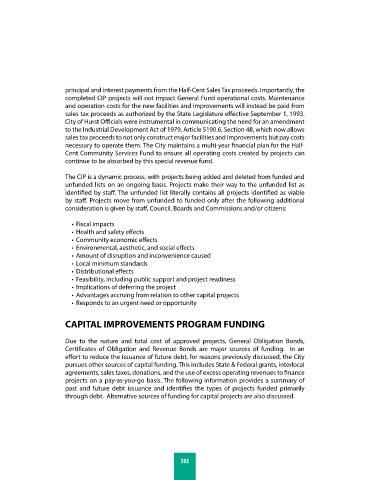Page 520 - Hurst FY19 Approved Budget
P. 520
principal and interest payments from the Half-Cent Sales Tax proceeds. Importantly, the
completed CIP projects will not impact General Fund operational costs. Maintenance
and operation costs for the new facilities and improvements will instead be paid from
sales tax proceeds as authorized by the State Legislature effective September 1, 1993.
City of Hurst Officials were instrumental in communicating the need for an amendment
to the Industrial Development Act of 1979, Article 5190.6, Section 4B, which now allows
sales tax proceeds to not only construct major facilities and improvements but pay costs
necessary to operate them. The City maintains a multi-year financial plan for the Half-
Cent Community Services Fund to ensure all operating costs created by projects can
continue to be absorbed by this special revenue fund.
The CIP is a dynamic process, with projects being added and deleted from funded and
unfunded lists on an ongoing basis. Projects make their way to the unfunded list as
identified by staff. The unfunded list literally contains all projects identified as viable
by staff. Projects move from unfunded to funded only after the following additional
consideration is given by staff, Council, Boards and Commissions and/or citizens:
• Fiscal impacts
• Health and safety effects
• Community economic effects
• Environmental, aesthetic, and social effects
• Amount of disruption and inconvenience caused
• Local minimum standards
• Distributional effects
• Feasibility, including public support and project readiness
• Implications of deferring the project
• Advantages accruing from relation to other capital projects
• Responds to an urgent need or opportunity
CAPITAL IMPROVEMENTS PROGRAM FUNDING
Due to the nature and total cost of approved projects, General Obligation Bonds,
Certificates of Obligation and Revenue Bonds are major sources of funding. In an
effort to reduce the issuance of future debt, for reasons previously discussed, the City
pursues other sources of capital funding. This includes State & Federal grants, interlocal
agreements, sales taxes, donations, and the use of excess operating revenues to finance
projects on a pay-as-you-go basis. The following information provides a summary of
past and future debt issuance and identifies the types of projects funded primarily
through debt. Alternative sources of funding for capital projects are also discussed.
503

